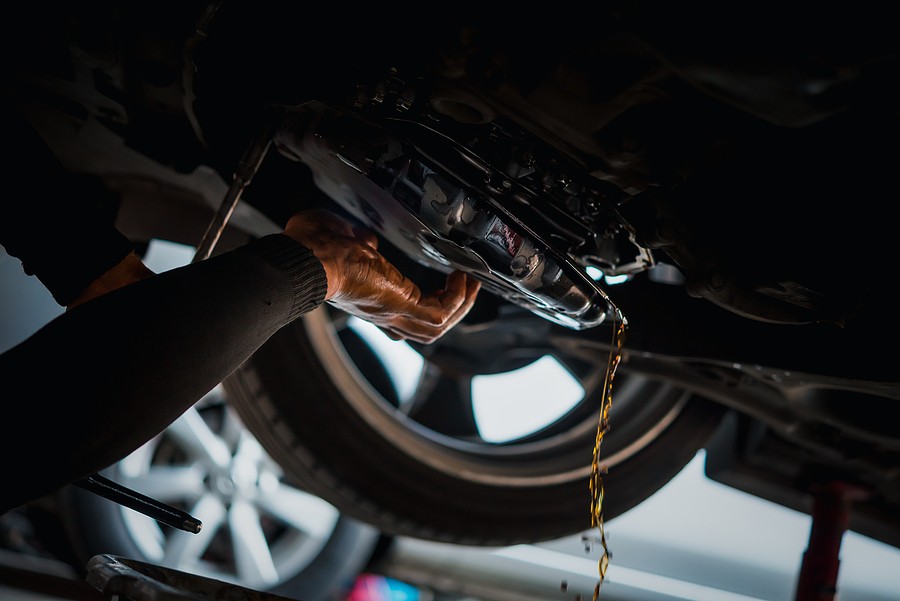If you keep filling up your transmission fluid and when you check it again, it seems like you didn’t just fill it up and is still low. You don’t know how it happened and you just scratch your head in confusion wondering, how does transmission fluid get low? It can be a puzzle, but there is always a reason for that. So you ask, how does transmission fluid get low? It can get low when there are some problems in your transmission system or its neighboring components. Problems like a transmission pan gasket failure, transmission pan crack or puncture, seal failure, fluid line crack, or a torque converter failure can be the reasons why your transmission fluid gets low.
How Does Transmission Fluid Get Low: What causes low transmission fluid?
The transmission is a gearbox with gear and gear trains that supplies speed and torque conversions from the engine to the wheels. It is one of the important components of the vehicle since it is basically the one that moves the power from the engine to the wheels.
The transmission fluid is the one that lubricates the transmission’s components since a proper lubrication is needed for its optimum performance. People who wonder “how does transmission fluid get low?” know how important proper lubrication is since without it, the transmission and its components will experience significant wear. Low transmission fluid level can also cause a lot of problems with your transmission.
The transmission fluid not only lubricates the different parts of the transmission, but it also cleans and protects its metal surfaces, helps cool down the high operating temperatures, conditions the gaskets, and helps increase its rotational speed as well as the temperature range.
So how does transmission fluid get low? A vehicle does not usually lose transmission fluid during normal operation. If its level gets low, it is most likely caused by a leak. The transmission usually experiences leaks because of some minor issues, but there are times when it is caused by severe problems. Whatever problem or parts that are causing the leak, it is always a good idea to have it checked as soon as possible.
You simply cannot ignore a transmission fluid leak or a low transmission fluid level. If you do, the problem will get much worse and it will become something that can be very expensive to fix. Here are some of the causes of a transmission fluid leak that can answer the question, how does transmission fluid get low?
- Transmission Pan or Drain Plug
Like any other parts of the vehicle, the transmission pan is also subjected to wear and tear. It is because the pan of the vehicle's transmission is prone to damage when you are driving from all the loose rocks, sharp objects and debris on the road. The transmission pan tends to get small holes or punctures from these objects that can cause it to leak.
There are instances where the drivers do not notice the leaks caused by small punctures or holes. Maybe they will just get confused asking, how does transmission fluid get low? However, if the puncture is big, the transmission will lose fluid faster and then the drivers would know immediately what the problem is and have it fixed. Loose drain plugs or bolts, and overtightened ones, can also cause the fluid transmission to leak. If you suspect that you have a problem with a leaking transmission fluid, you need to inspect these parts to make sure that they are the one causing it.
- Transmission pan gasket failure.
The transmission pan gasket is the mechanical seal which is placed between the pan and the transmission. It is the one that keeps the transmission fluid from getting out when it is being transferred from the pan into the transmission.
This transmission pan gasket can become cracked or damaged caused by poor manufacturing, or being exposed to hot temperatures all the time. If you recently just installed one, bad gasket alignment can also cause it to become damaged and when it does, it can cause the transmission fluid to leak. This part is usually easy and cheap to replace so it is better that you have the problem corrected immediately before the problem gets worse.
- Damaged seals.
The transmission of the vehicle has a variety of seals that are either made of metal or rubber. These seals are regularly exposed to temperatures that can go from 195 to 220 degrees Fahrenheit and this enormous amount of heat can somehow affect these seals. They will eventually crack or get damaged due to normal wear and tear. When this happens, this could cause the transmission fluid to leak through them.
If you have transmission fluid caused by a cracked or damaged seal, you can check several areas of your transmission to know the exact location of the leak. You will usually find the damaged seal in either input shaft or the output shaft. You also need to check the transmission pan, plug seals, driveshafts, shifter housing seals, tail housing seals, sensors, valve body, and speedometer input seal to find what is causing your transmission fluid to get low.
- Damaged fluid lines.
The transmission of a vehicle has fluid lines that are made of either steel or aluminum. It is where the transmission fluid travels to different areas in the transmission. These fluid lines are known to be quite sturdy and are built to last but they can get damaged or cracked due to extreme exposure to heat, road debris, or because of age. They can even completely break. When these fluid lines get damaged, the transmission fluid will no longer circulate through the transmission but will leak out instead.
- Cracked torque pump.
The torque converter pump is the one that moves the transmission fluid into the whole transmission system. If this part gets cracked or damaged, it will cause the transmission fluid to leak or stop the fluid circulation. If this is the reason why you have a leak and if it answers the question, “how does transmission fluid get low?”, then you better contact a mechanic and have it repaired immediately. A fluid leak caused by a damaged or cracked torque converter pump can usually only be repaired by replacing it.
How Does Transmission Fluid Get Low: What are the symptoms of low transmission fluid?
It is very important that your vehicle always has the correct level of transmission fluid. It makes sure that everything runs smoothly by lubricating and cooling the internal parts of the transmission. It also helps keep the vehicle’s transmission to shift smoothly and on time. That is why many drivers that are experiencing low levels of transmission fluid tend to ask, how does transmission fluid get low? They know that this issue can cause bigger problems if it is not fixed right away.
We already went through the possible causes of why and how does transmission fluid get low and it is generally caused by leaks. But how will you know if you have a low transmission fluid or if it is leaking? Here are some of the common indicators of a low transmission fluid:
- Transmission overheats.
One of the symptoms of a low transmission fluid is an overheating transmission. If your vehicle suddenly has power loss, or when you notice smoke coming from your car, erratic shifts, or a burning smell, you need to pull over right away. These are the indicators of an overheated transmission and it can be caused by a lack of fluid.
The transmission can overheat when your transmission fluid gets too low since it won’t be able to help lubricate its components to lessen the friction. Friction can cause these components to heat up. It is best that you don’t ignore this problem and pull over immediately. If you continue to drive your vehicle with an overheated transmission, it can lead to some serious internal damages.
- Strange noises.
A transmission that is properly working doesn't have any unusual sounds or noise when you are driving and should be able to transition smoothly. If you hear strange noises coming from your vehicle, especially when you are in gear or changing gears, it could be an indication that you are low on the transmission fluid. You might hear a humming or a whining sound for an automatic transmission while a manual one could give off a sound like a loud clunk or a grinding noise.
Low transmission fluid can cause your vehicle to produce strange noises since poor lubrication can result in bands, clutches, and other components to rub together. If you hear unusual noises coming from your vehicle while driving, it is best that you have it inspected by a professional as soon as possible to prevent experiencing other problems.
- Shifting problems.
You might encounter some shifting problems when you try to shift gears when your vehicle has a low transmission fluid. You might experience some resistance when you do it. This is because both manual and automatic transmissions must have an appropriate amount of clean transmission fluid so it can flow freely in the transmission. Low fluid level can result in a vehicle that changes gears too late or too soon and sometimes, you can’t even get to a certain gear at all. A contaminated fluid can also cause a very laggy and sluggish response. To correct the problem, you need to add transmission fluid until you get the appropriate amount. If for some reason it still gets low and you ask, how does transmission fluid get low so easily, you might have a leak and you need to have it checked, find out what causes it, and have it repaired immediately.
- Gears slipping.
A low transmission fluid does not only make it hard to shift gears but it can also cause them to slip. Gear or transmission slipping can happen when there is a poor synchronization between the vehicle and the engine. It can happen when the transmission slips out of gear on its own or the engaged gear slips and does not stay in the selected mode. This is because as the engine speeds up, the car is not responding. This problem is dangerous and it is the reason why you don’t drive a vehicle that has a low transmission fluid. This can happen because of low hydraulic pressure.
- Transmission leak.
If you see a bright red fluid under your vehicle, it is an indication that your transmission fluid is leaking. It is not a good sign since that fluid is the only source of lubrication for the transmission housing of the vehicle. The transmission fluid also functions as a cleaning and conditioning agent for the neighboring seals. You need to have it repaired immediately since the leak will continue to worsen and when the fluid level drops, it can cause problems that can be costly to repair.
If you have experienced any of the symptoms of a low transmission fluid, you need to check and confirm that it is not caused by any other issues. You can check your transmission fluid if it is indeed low or if the fluid is free from contaminants. You just need to use the dipstick and check if the fluid level is the same as the one specified in the owner’s manual. If it is not, you can fill it up but be careful not to overfill or spill the transmission fluid on the hot engine parts.
You also need to check the transmission fluid’s color or smell. If it smells burnt or has a dark color, or stays low even after filling it up, you will have to make an appointment at a service or repair shop to correct it.
Asking “how does transmission fluid get low?” can help you understand what causes low transmission fluid and can help you prevent it from happening. You do not just ask what causes it but you also need to make sure that when it happens, you will act on it and fix the problem as soon as possible.



